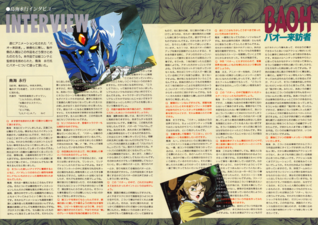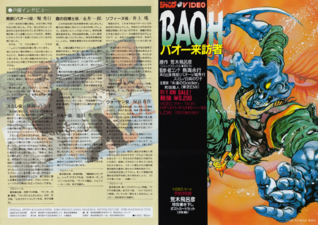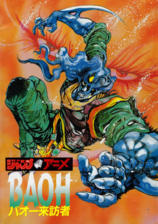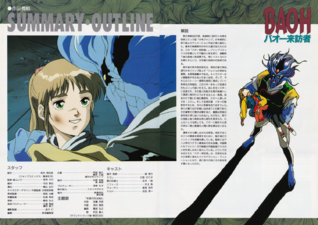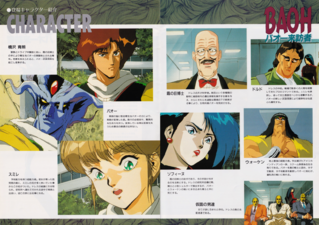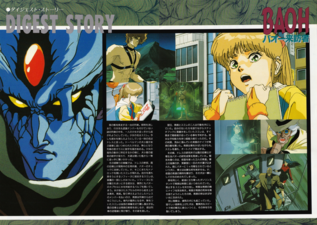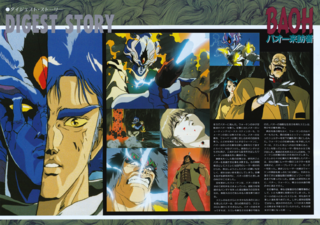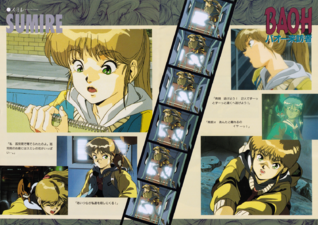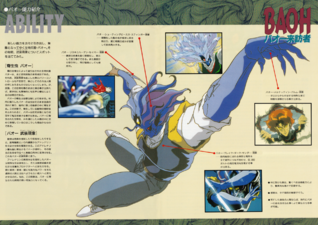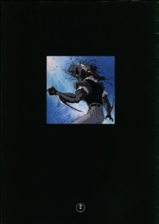Pafu (April 1989)
Interview Archive
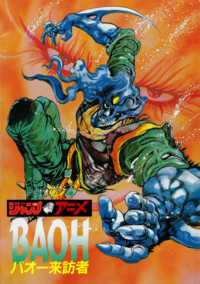
An interview with Hisayuki Toriumi (Chief Supervisor and Storyboard Artist of the Baoh the Visitor OVA) and comments from the following voice actors: Hideyuki Hori (Ikuro Hashizawa), Ichiro Nagai (Dr. Kasuminome), Yo Inoue (Sophine), Noriko Hidaka (Sumire), Shuichi Ikeda (Dordo), and Yusaku Yara (Walken). These were published in a 1989 theater pamphlet.
Interview
Hisayuki Toriumi
Born in Yokohama in 1941. Graduated from Chuo University. After working at Tatsunoko Production, he joined Studio Pierrot. Notable works of his include Science Ninja Team Gatchaman, The Wonderful Adventures of Nils, The Mysterious Cities of Gold, Dallos, Area 88, and Lily C.A.T., among others.
Q: First of all, can you tell us about your first impression of the original work?
Toriumi: I was shocked. To be honest, it was quite a surprise. I don't usually read violent comics regardless, but I was still surprised to see how far comics have come nowadays. I was also impressed by the outrageous things young people think up nowadays. They really have flipped common sense on its head. For example, the scythe coming out of Baoh's arm was something we used to have to do with props in the past. He fights by transforming his body itself into that kind of weapon. That was wild to me.
Q: As you marveled at those new ideas, was there any doubt in your mind as to whether you could get away with visualizing those extreme depictions of violence in the film?
Toriumi: That's my biggest concern. There was a lot of discussion around the topic at first, but we couldn't come up with a clear answer, and in the end we decided to go with whatever was within the scope of the original work. Even then, when you watch the animation on the screen, it somehow lacks that sense of unpleasantness we aimed to recreate. It's simply impossible to recreate the texture of it. However grotesque you draw them, the images look beautiful once cel-shaded. So no matter how much blood is splattered, I don't feel the slightest bit uncomfortable watching it. The mutilation scenes are disgusting, but it doesn't carry the same shock value as, say, The Fly. On the contrary, I thought that if those kinds of scenes accumulated and were made more dynamic than unpleasant, the sadness of the protagonist, who has been altered without his permission and is no longer a regular human being, would rise to the surface. He loses his speech when he transforms into Baoh, so it was necessary to have him express it with his entire body. The other characters in this film really don't have many lines either, though.
Q: It's not just the dialogue; the cast of characters is also rather sparse.
Toriumi: Normally, the story is told through dialogue, but in Baoh the story is told through movement. Ultimately, it attempts to express the contrast between the intensity, the subtlety, and the loneliness of the action through both stillness and movement.
Q: What were you particularly attentive toward when supervising the film?
Toriumi: When I storyboarded the film, though it was very difficult, I made sure to only include one action per cut. Previously, there were cases where we would put 10 to 20 movements in a single cut, and sometimes they could take up a long stretch of time. Naturally, the cuts are shorter, but it's still a lot of work overall. Faces are melted, arms are cut off, et cetera, but it doesn't really matter how shocking they are in the drawing stages, so I left it up to the director. I wonder how difficult it'd be to keep doing things that way again and again.
Q: I was shown the storyboards earlier, and you gave very detailed instructions as to how to handle firearms and depict cartridges popping out, and so on; for example, "don't use repeats for this shot," and so on. Is that because you wanted to maximize the grade of each movement?
Toriumi: It's difficult to accurately convey my intentions to others. The parts I want to be done in one way are ignored, and the parts I don't want to be done in another way are persistently done that way. So I just gave them instructions on what I wanted them to do. Realism is expressed in the subtlest of ways. Just the characters being realistic doesn't make the whole thing realistic, right? Realism is felt through the smallest details of the work.
Q: Were there any particular aspects of the work itself, like the drawing or recording, that you paid particular attention to this time around?
Toriumi: Regarding filming techniques, each studio has their own restrictions, so we can't give too many unreasonable orders. As for the audio, we had a meeting the other day about Baoh's "barubaru" cry. That howl is a sound that can be transmitted through either the vocal cords of an animal or a human being, so we decided to make the most of it. It is the bark of a monster, but unlike the howl of a dog, which sounds like "wooooooo," it has to be a "barubarubaru." It's rather like the sound of a motorcycle's exhaust pipe. I don't want it to be a mechanical sound, but rather a voice coming from a human throat. I want the bark to express emotion. It has to vary based on that, whether Baoh is grieving, furious, or defensive. I believe that Baoh's howl will make or break this work.
Q: What is the one thing you wanted kept in mind above all else in Baoh?
Toriumi: It's just a matter of screen composition, but I asked them not to use the common practice of dividing the screen into three or four screens via masking. If you were to ask me why, I would say that there's just no need to go to the trouble of dividing the screen into smaller pieces. A movie's coherence comes from following the images within a frame, and dividing a picture into two parts, one on the right and the other on the left, should only be used when it is found to be the most effective. It's not something you can do just for fun. So I want it to be realistic and vivid. The other thing is that, if I have captured a close-up of Baoh's face from a frontal view, I don't want it to be changed without my permission just because it would look cooler as a low-angle shot. Of course, if it were a single picture, it would be cooler to draw the face from below rather than from the front. But that would ruin the interactions between each cut. For example, when two people are talking together, like we're doing now, there's no need to use low-angle shots at all. And that's what I'm concerned about. Since Baoh is an action movie, it's tempting to try and make every picture as cool as possible while ignoring the flow of the story. I tried to keep that in check as much as possible to create an atmosphere that emerges from the screen.
Q: In the opening scene, the way Sumire escapes from her room and Sophine chases after her is depicted gives off the impression of a suspense film from the 1960s.
Toriumi: Yes, that's right. Since Baoh is a bloody world, I felt that I could bring out a bit of romanticism in the way the suspense builds there.
Q: I'd like to ask what your favorite scene in the entire film is.
Toriumi: Hmm. Well, I like to build up suspense with a quiet mood. The scene that I was most careful about in the storyboarding stage was the one where Sumire and Ikuro are attacked in an abandoned building. Ikuro doesn't even know what he looks like as he fights there. The part I'd like to see handled with the most care is the part where he sees his reflection in the mirror.
Q: Conversely, is there anything you think should have been handled a little better?
Toriumi: I was most concerned about Nozzo. I think Mr. Hirohiko Araki, the author of the original story, was planning to use her for something, but in the end he simply couldn't use her effectively enough. She's a fictional animal, so to have her appear means he must've been planning to use her to progress the story somehow. It really is a shame.
Q: Did you gain anything new from working on Baoh?
Toriumi: Yes. I enjoyed getting to know the animators and other new members that I had never met before. When I saw the finished film, I discovered new things about it that I didn't even know were possible.
Q: What theme did you want to convey in Baoh?
Toriumi: It's not a particularly grandiose theme, but there are times when people cannot convey their true intent to others. Even if there's no malicious intent involved, our inability to convey our intentions causes us to be misunderstood and judged as such. When Ikuro transforms into Baoh, he is unable to communicate with others, and no one understands that he is still Ikuro. The question is why Baoh still fights for others, lonely as he is. I think it's interesting that he isn't simply heroic with a sense of justice.
Q: Is there any policy that you keep in mind when creating your films?
Toriumi: It's a simple one. I try to convey to the viewer the entire world that I bring forth. The most important thing is to not make any typos. There are people who say that if you try to make your films too easy to understand, they become boring. But I think it's important not to just tell a story where people will think, "Ah, so that's the message of their filmography." In order to convey the message of the work via the story, I must emphasize the importance of grammar. We use Japanese grammar to enhance the Japanese language, and the same can be said of film.
Q: Do you hope to continue making films like this in the future?
Toriumi: Well, I still haven't decided what kind of film I'm best suited for. It just so happens that I started out in the action genre, and since I do those so well, people tend to assume they're my specialty. I wanted to do something fairy tale-like, but the opportunity never presented itself. Things had been that way for over a decade, so it was fun when I started working at Pierrot. I thought it would be fun to look at things through the eyes of a child. In the end, both action and fairy tale works are enjoyable in their own way, but I don't think animation is limited to simply the realm of entertainment. When I watch When the Wind Blows, for example, I think to myself that this is the kind of work we really need to be creating. That's something our generation is a bit particular about, so in a sense, it's a very Japanese reflection to make. When the Wind Blows was an exception, but when we first entered the world of animation, we were ridiculed for it, since animation was just something for children to watch. But if children are watching it, their parents must be watching it, too, so we came together as an organization to create works that the parents wouldn't scoff at. We wanted to create films that could be watched by both children and adults. It's a bit extravagant, saying it out loud, but that's the kind of film I'd like to make.
Q: Finally, do you have a message for the fans out there?
Toriumi: Considering the current social climate, a work like this has phenomenally bad timing (laughs). So I want the audience to grasp not just the superficial action, but also the heart of Ikuro deeper within. The action is just decoration, so can you try and look at the core of it? We are creating this work here around being able to understand that. I don't know if we're living through a yōkai boom or not, but I would like the meaning behind the existence of yōkai to become more apparent. If it properly depicts a sense of human psychology and the value of existence, the meaning behind these monsters and yōkai existing, appearing where they do, then I think Baoh will turn out just fine. It shouldn't be just about slaughter or shock value. I hope that the audience for this film won't be caught up in the violence on the surface, but will instead sense the message of the filmmakers beneath all the violence.
鳥海 永行
1941年、横浜生れ。 中央大学卒。
竜の子プロを経て、スタジオぴえろ設立に加わる。
代表作「科学忍者隊ガッチャマン」
「ニルズのふしぎな旅」
「太陽の子エステバン」
「ダロス」
「地域88」
「LILY-C.A.T」など
Q まず原作を読まれだ第一印象から聞かせて項けますか?
鳥海 本当にビックリしましたよ。正直これは驚きでしたね。僕はもともとバイオレンス系統のモノは読まないんですが、今のコミックはここまでやっているのかっていう感じでしたね。それから今の若い人はホントとんでもない事考えるんだなって感心しました。常識をひっくりがえしてしまっているんですよ。例えばバオーの腕から鎌が出てくるっていうのは、僕等は昔、小道具を持たせてやっていた訳ですね。自分の体をそういった武器に変化させて戦ってゆく。これはとんでもない事考えるんだなど思いました。
Q そういった新しいアイデアに驚嘆するとともに、バイオレンスのきわどい描写を映像化してもいいものかといった疑問を持たれませんでしたか。
鳥海 それは一番気になるところなんですけどね。それについては最初色々ディスカッションしたんだけど明解な答えが得られなくて、結局、原作の中でやっている範囲内の事ならともかくやってみようという事になったんです。それからアニメーションも画面を観て項くと案外狙った気持悪さは出ないんですよ。質感の表現にどうしても無理があるんですね。グロテスクに描いても、セル画になってものはキレイに見えてしまうんです。だからどんなに血しぶぎ出したってそんなに観てて気持悪くはならない。切るという行為は抵抗感じますけど、例えば「ザ・フライ」を観たような、ああいうショックはおきないんだと。逆にそういうシーンを積み重ねて気持悪さよりもダイナミックさが出れば、勝手に改造されて普通の人間ではなくなってしまった主人公の悲しみが出てくるのではないかと思ったんです。彼はバオーになると言葉を失うわけですから、それを体全体で表現させる必要があるわけです。主人公に限らず、この作品は本当にセリフが少ないんですよ。
Q セリフのみならず、登場キャラクターも比較的少なめですね。
鳥海 普通はセリフでドンドンドンドン積み重ねていくのに対して、「バオー」は動きの積み重ねにより物語を語らせているんです。結局それはアクションのすさまじさと繊細さと孤独さの部分の対比を「静」と「動」でもって表現しようとしているものなんですね。
Q 今回演出をされる上で、特に意識した事というのはあるのでしょうか。
鳥海 僕の方は絵コンテを切るときに、大変だとは思いますけども、ワンカット、ワンアクションしか入れてないんですよね。今までですとワンカットの中に芝居を10も20も突っ込む場合もあるし秒数を長くとったりする事もあるんですけど。当然カットは短くなりましたが、それでも全体的に大変でしょうね。顔が溶けたり腕を切ったり、それを絵の段階ではどんなにショックでもかまわないって事で、演出家さんにふりましたから。そういった事を重ねていくのは難しいんじゃないのかなって気もしますけどねェ。
Q 絵コンテを見せてもらったんですが、銃器の扱いに関してや
鳥海 自身の意向を正確に相手に伝えるのは難しいんですよね。こちらが「こうやって欲しいのに」っていうとこは案外サラッと無視されちゃって、「ここはどうだっていいのに」というところをしつこくやるというのがありますから。だから気になる所だけは、「こうして下さい」って指示をさせてもらいました。リアルさというものはなにげない所ででてくるんですよね。キャラクターがリアルだからリアルってわけではないんじゃないですか?芝居のちょっとした所にリアルさを感じるっていう事あるでしょ。
Q 作画や録音等の実作業の点で、今回特にこだわった点というのはあるでしょうか。
鳥海 撮影技術に関しては、各スタジオごとに制約があるますから、あまりムチャな注文は出せないんです。音響では、この前も打合せをしたんですが、バオーの「バルバル。」ですね。あの吠え声、あれがあくまで動物の、人間の声帯を伝わってくるものであるから、これはとにかく大事に作っていこうと。怪獣の吠え声には違いないんだけれども「ウォー」っていう犬の遠吠えとは違って「バルバルバル。」っていう「ル」音が入りますからね。 オートバイの排気音に近くなるんでしょうか。これは機械音ではなく、あくまで、人間のノドから流れてくる声にしてもらいたいんです。その吠え声だけでもって感情表現してもらいたいと。悲しい時のバオーとか、怒りのバオーとか、怒りを耐えてる場合のバオーとか、色々ある訳ですから。この作品を良くするか悪くするかがこのバオーの吠え声で決まってしまうと思いますね。
Q この「バオー」の中で、これだけは押さえておきたかったポイントというのは何でしょう。
鳥海 画面の構成上の問題なんですけども、よくやるマスクに分けて画面を3つ4つに分けるやり方、こういう事はやめてくれとお願いしました。それは、なぜと聞かれれば、せっかくの画面をわざわざ細かく分ける必要は無いんだと。映画というのはあくまでフレームの中でもって画像を追っていって説明するもので、右に誰かの絵、左に誰かの絵って分けてしまうのは、それが一番効果的だと判断した時に使うべきなんです。遊びでやるってものではないんですよ。だからあくまでリアルに、生々とした感じでやって欲しいと思っています。もう1つは、例えばバオーの顔のアップを僕が正面顔でとらえたとすると、それを作画する時に、アオリの方がかっこいいからといって勝手に変えられては困るという事です。そりゃあ、1枚の絵だったら正面の顔描くよりも、アオった方がかっこいいですよね。でもそれではカットがつながっていかなくなる。例えばこうやって2人で一緒に話している時にアオリを使う必要は、全くないですよね。僕が気になるのはそういうところなんですよ。前後の流れというものを無視されて1枚の絵のかっこよさを追究されちゃうと、ついバオーっていうのはアクション物ですからそっちの方に流れやすいんですね。なるべくそれを抑えて画面から醸し出される雰囲気作りに専念しました。
Q 冒頭のシーンなんですけども、部屋を脱出したスミレとそれを追うソフィーヌの描写が60年代のサスペンスタッチな映画という印象を受けたんですが、それは意識されての事ですか。
鳥海 そうですね。「バオー」は血みどろの世界ですから、ちょっとロマンティックな香りみたいなものがサスペンスの盛上げ方とかで出せればな、という気がしたんです。
Q 全編を通じて監督の「ここはっ」というお薦めのシーンをお聞きしたいのですが。
鳥海 んー。どちらかというと僕は静かなムードでサスペンスを盛上げるのが好きでしてね。一番、絵コンテの段階で気をつかっているのは、スミレと育朗が廃墟のビルに居てそこを襲われるという、あのへんのくだりなんです。あの中で戦っている育朗が自分がどういう姿をしているがわからない。それが鏡に映しだされる事によりわかってくるあたりを一番丁寧にやってもらいたいんですが。
Q 逆にここはもう少しこうすべきであったという所はありますか。
鳥海 一番気になってたのはノッツォなんですね。あれは原作の荒木(飛呂彦)さんも何かに使おうと思ってらしたと思うんですよ。 それは十分有効に活されていない。あれは架空の動物ですから、そういうものを登場させたのならストーリーを展開していく上で何かにからませたかった。それが残念です。
Q 今回「バオー」にたずさわられて、監督自身何か新しいものを得られたという事はあるでしょうか。
鳥海 ええ、アニメーターを始め、これまでおつきあいの無かった新しいメンバーと知り合いになれたのが楽しかったです。あがってきたフィルムを観せてもらって、「こういう事ができるのか。」っていう新しい発見もありました。
Q この「バオー」の中で監督がいいたかったテーマといったものは何でしょう。
鳥海 テーマという程大げさなものでもないですが、人間誰にも自分の本意が相手に伝わらないって事ありますよね。悪意がなくても本音を伝えられない事で誤解されて、あいつはこういう人間だって決め付けられてしまうっていう事が。育朗っていうのはバオーに変身してしまうと意志の疎通も出来ないし自分を育朗だと分かってくれる人もいない訳ですね。そういう孤独なバオーが人の為に戦うのはなぜなのかといったところなんです。単なる正義感のヒロイズムじゃないところが面白いんでしょうね。
Q 監督自身がフィルム構成されていく中で、常に念頭に置がれているポリシーといったものはありますか。
鳥海 これはもう単純でしてね。観る人になるべく自分が訴える世界全部をわけるようにするって事ですね。文法を間違えちゃいけないって事を一番大事にしている訳です。わかりやすいように、わかりやすいようにってやるとかえってつまんないっていう人もいましたけどね。ああこの人は一作一作こういう事が言いたかったんだと、ただストーリーを教えるだけじゃいけないんですよね。ストーリーを通してこの作品はこういう事を訴えたいってものを出す為には、文法を大事にしていかなきゃいけない。僕等が日本語を際すために日本語の文法を使っているのと同じように、映画にも同じ事が言えるんです。
Q 将来監督自身こういう作品を作ってみたいという希望はありますか。
鳥海 そうですね、自分にどういう作品があっているのか、まだ決められない部分があるんですよね。たまたま僕はアクションもので出てきたという事もあって、それなりの事ができちゃうとあいつはアクション物がいいだろうと勝手に決められてしまう部分があるんです。本当はメルヘンチックな物をやりたいと思ってもなかなかチャンスが巡って来ない。そういう経験が十何年と続いていましたから、ぴえろを作った時は楽しかったですよね。子供の目線と同じ高さで物を見ていく事は楽しい事だと。結局アクション物もメルヘン物も、やってみればそれなりの楽しさがあるんですが、アニメって、そういう娯楽作品しか作れないわけじゃないだろうと思うんです。例えば「風が吹く時」みたいに、ああいうの観てると本当にこういうのは我々が作んなきゃいけないんだと思いますね。ああいうものってのは僕等の世代ちょっとこだわりがあるから、ある意味では日本独特の反省になってしまう。そうじゃない感覚が「風が吹く時」だったんですけど、僕等がこういう世界に入った時アニメなんて子供が観るものだとバカにされた訳ですよね。ところが子供が観ていれば絶対親も観ている訳だからその親にどうのこうの言われない物をつくろうという組織でやってきたんです。子供から大人まで観られる作品。ていうのは贅沢な話ですが、いつか作ってみたいですよね。
鳥海 今、こういう社会事情ですからこういう作品は非常にタイミングがまずいんですよねぇ(笑)。だから僕は表面的なアクションだけでなく、あくまでも内側に流れている育朗の心をつかんで欲しいです。アクションはあくまでデコレーションで、その核をみてくれないでしょうか。それがわかるように現場では作っていますので。今、妖怪ブームみたいなものでそういうジャンルが受ける時代なのかもわからないけど、僕はその存在意味をもっと出してもらいたいと思っていますね。なぜこのバケモノや妖怪がいるのか、なぜでてくるのか、そこにもっと人間の心理をついているものとか、存在価値というのがちゃんと描かれていれば僕はこの「バオー」もいいと思うんですよね。それがただ殺される為に、ショックを与える為に、だけじゃいけないと思うんです。この作品では、表面のバイオレンスな部分だけに捕らわれず、その奥に込められた製作者側のメッセージを感じ取って頂きたいです。
Gallery
Site Navigation
Warning: Display title "BAOH OVA Pamphlet (September 1989)" overrides earlier display title "Baoh OVA Pamphlet (September 1989)".
